





It's actually quite simple: bowlines are all you need to attach the sheets to the headsail. The widely used knot is secure, can be opened easily even under high loads and every sailor knows how to use it. This method of sheet-sail connection is therefore also the most common and generally practised by shipyards on keel yachts. But as is so often the case, there are better, more elegant and more practical ways. This is because the bowline is bulky, can get caught and looks messy.
Variants of the bowline
Various variants are possible: Different knots, such as a simple half hitch with only one continuous sheet, or running weaving lines with two lines, reduce the amount of line build-up. Solutions with fore-strops between the sail and sheets enable shorter lines and, above all, the unused sheet of a set high-cut headsail such as a code zero or gennaker can be knotted on or off. This is helpful in the event of a wailing or incorrect line management after hoisting the sail and generally speaks in favour of using two single sheets instead of one continuous sheet. The same applies to the option of being able to replace a sheet during use, for example to switch to a lighter line when the wind drops on the gennaker.
Elegant solutions with aluminium thimbles in the spliced bulkhead ramps prevent the risk of damage. Snap shackles or patent shackles speed up the attachment and detachment process. And textile sheet shackles are also very easy to detach, but do not hit the mast or deck and are not only easy to buy, but also easy to make yourself.
Advantages of Dyneema
Line management has become much simpler and more efficient since the introduction of the high-performance fibre with the trade name Dyneema in the 1980s. The synthetic fibre, a polyethylene derivative, has everything that sailors want: It is resistant to abrasion, UV radiation and moisture. And above all, it is 15 times stronger by weight than steel and also significantly more resistant to tension than polyester or even aramid fibres such as Kevlar.
This makes it a welcome choice where low weight and high strength are an ideal combination, for example in halyards where a high breaking load and low elongation are required. The same applies to sheets made from Dyneema, which need to be re-trimmed less often and can be thinner.
The sheets can be spliced quite easily if you dispense with the cover in the end area, which does not contribute to the strength of high-quality cordage anyway. It is pushed back, the splice is made and then the sheathing is milked back over the splice and secured with a rigging.
The eye splice in the sheets or strops can be realised by simply inserting the core into itself or by using a so-called brummel splice, which not only holds onto the core by contracting the surrounding braid, but also mechanically prevents it from slipping.
Dyneema material is also ideal for rope shackles, slings and loops, which have many advantages over metal connections: high tensile strength, low elongation and simple production with various customisation options. The owner can choose between shackles of different lengths, open or closed, multi-stage or extended with a sling. Shackles, loops and slings are best made from core material that is easy to splice. Partial protective sheaths can be subsequently applied to mechanically stressed areas.
Instructions for cordage work:
Connection 1: Two sheets with two bowlines
The most widely used method of connecting sheets to the headsail: two lines, two bowlines, done. Simple, easy to untie knots. Two sheets instead of one long sheet always have the advantage that the unused windward sheet can be used as an outer sheet or in the case of overruns, and a wailing is easier to fix.
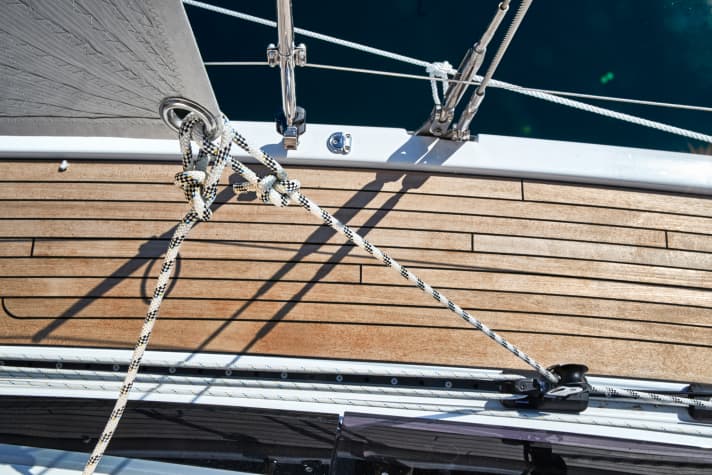
Advantages
- Simple, known knot
- Great flexibility thanks to two pods
Disadvantage
- Large knots can get caught more easily on the shrouds in tacks
Connection 2: A sheet with half lay
The simplest method of connecting sails and sheets uses the simplest knot, the half hitch. This variant is popular on dinghies, where the sheets remain on the sails and are then also used to tie them together after folding.
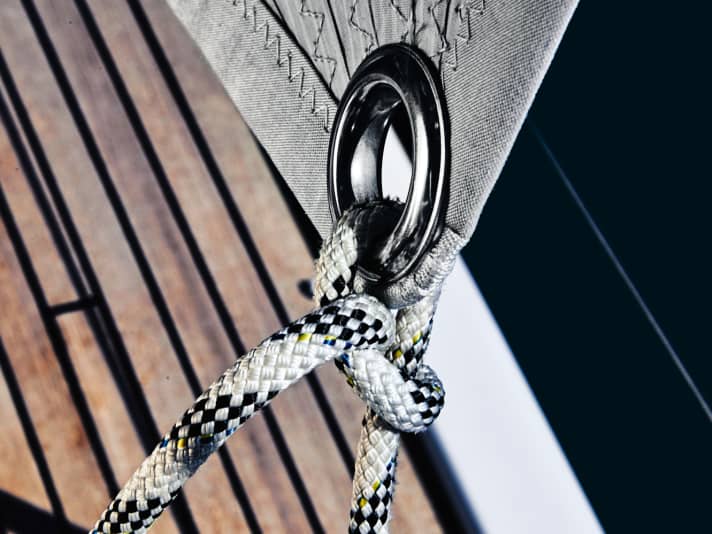
Advantages
- Knot builds up little
- Elegant connection
- Low risk of snagging
Disadvantages
- Knot can slip or is difficult to undo once it has been heavily loaded
- Low flexibility due to only one sheet
Connection 3: With half strokes secured
Two sheets and half hitches secured by half hitches (or better, detachable figure-eight knots). This method builds up the least amount of material between the eye and the free sheet. Intended for jibes where the lift should be maximised. Also suitable for headsails, but not very elegant.
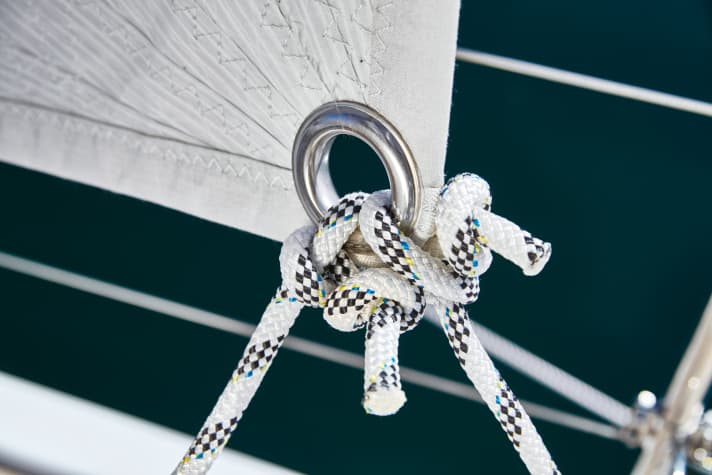
Advantages
- Knot builds up little
- Very durable connection
- Great flexibility thanks to two pods
Disadvantages
- Greater tendency to snag
- Difficult to open after high loads
- Visually unattractive
Connection 4: With running half strokes
The knot could be described as a running weave line knot and is also called a never-open-again knot. It is actually more suitable as a permanent connection for halyards and their shackles, as the connection is difficult to undo. There are two variants: The rope ends at the thimble or on the other side and closes the knot. The first method is the most difficult to untie, a blessing and a curse at the same time. But the knot holds well.
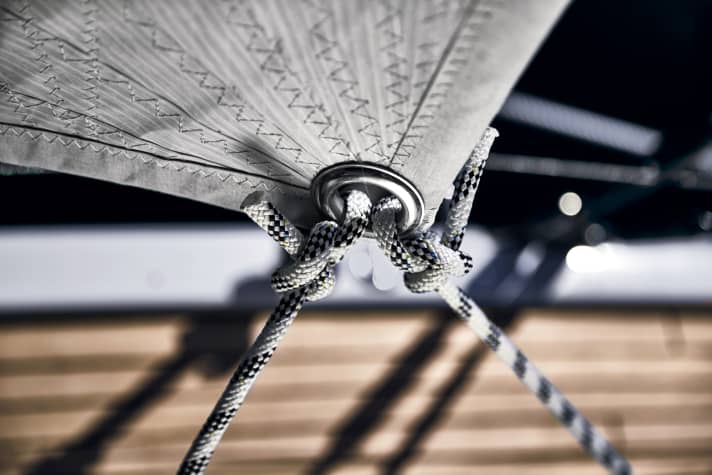
Advantages
- Compact connection
- Knot builds up little
- Flexible thanks to two pods
Disadvantages
- Knot is difficult to undo after high load
- No major advantages over other pure node connections
Connection 5: Sheets with rope shackles
It's all been done before and rediscovered: two sheets with spliced eyes and rope shackles. If their diamond knot is placed in the thimble, the connection offers little potential for snagging. To splice, the cover is pushed back and then milked over the splice.
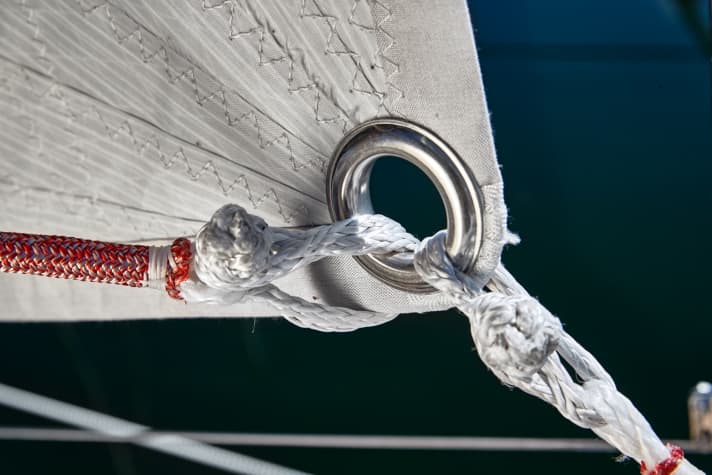
Advantages
- Knot builds up little
- Flexible thanks to two pods
- Connection relatively easy to release
- Elegant contemporary method
Disadvantage
- Needs to be replaced more often, as rope shackles in bare Dyneema can cause damage
Connection 6: Stropp and Palsteks
Saves running metres and can also be reached with a high clew: Connection with a knotted or spliced strop. Useful for code zero or with thinner sheets for the gennaker. Less suitable for jib or genoa.
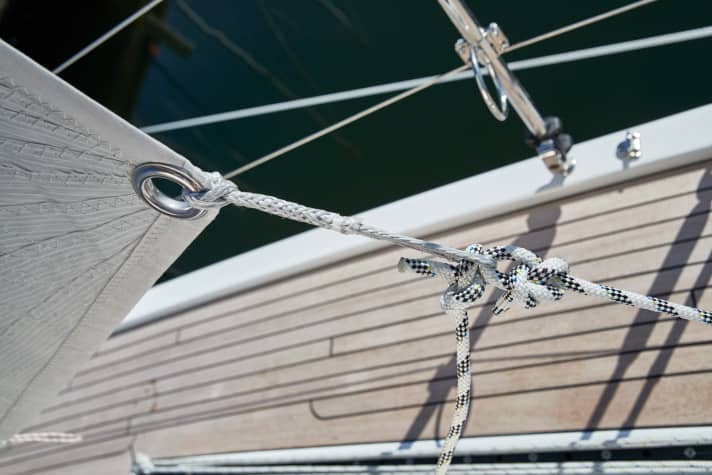
Advantages
- Good for high clews
- Flexible thanks to two pods
Disadvantages
- Knot eye in splice can chafe
- Two Palsteks build up strongly
- Great potential to become entangled
- Visually inelegant
Connection 7: Double strop with Schotsteks
The advantage of a short outhaul strop on the clew (regardless of which method is used) is that sheet metres can be saved, but this is only significant with high-cut sails. The strop and knots can be long enough to reach the headsail furling point, only then do the sheets follow. The strop can remain on the clew and be knotted with a weaving line or an anchor stitch (photo), for example. A strong Dyneema core into which two eyes are spliced is a suitable material.



Advantages
- Simple connection
- Small knots
- Flexible thanks to two pods
Disadvantages
- Two knots away from the clew have a greater potential for snagging
- Knots not well secured
Connection 8: Variants with rope shackle
A long strop or one with a built-in clew shackle and bowline or eye splice at the end are other methods that shift the connection between sheet and clew and are easier to reach from the deck.



Advantages
- Good for high clews
- Flexible thanks to two pods
- Connection relatively easy to release
- Palstek instead of splice better customisable
Disadvantages
- Two knots away from the clew have a greater potential for snagging
- Needs to be replaced more often, as rope shackles in bare Dyneema can cause damage
Connection 9: With splice, soft shackle and aluminium thimble
Elegant and functional finish with aluminium thimbles that protect the rope shackles and eye splices. To splice, push back the cover and then milk it over the splice and add rigging. Push diamond knots into the thimble so that the knot builds up even less.
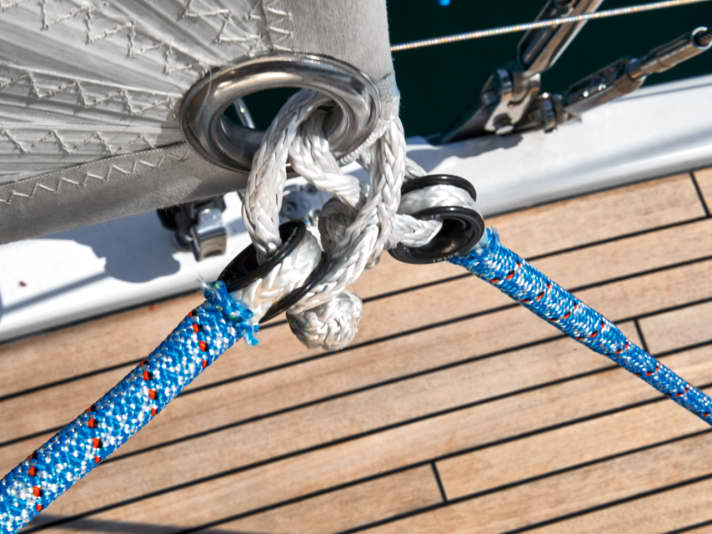
Advantages
- Knot builds up little
- Flexible thanks to two pods
- Connection relatively easy to release
- Elegant contemporary method
- No shaming due to aluminium thimbles
Disadvantages
- Even more metal that can hit the mast
- Higher costs due to thimbles
Connection 10: Stropp as Prusik
The mountain sports knot is an extended anchor stitch and can also be made from a simple line, which should ideally be thinner than the sheet. Intertwined three times and knotted together, the result is a durable and non-chafing connection from the simple sheet to the sail. The clew knot tightens under load and releases quickly when required. It holds particularly well on rough cover, but even works on bare core material. The knot is also the right choice when a sheet needs to be stopped, for example to place it on another winch.
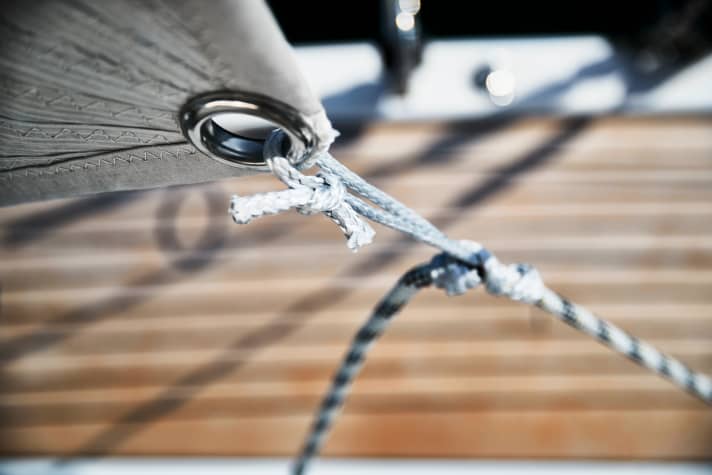
Advantages
- Knot builds up little
- Connection relatively easy to release
- Variable length depending on sling
Disadvantage
- Inflexible due to only one sheet
Connection 11: Long rope shackle as prusik
The Prusik knot from mountaineering is the ideal stopper knot. It is continuously looped into each other and clamps perfectly on the sheet. Made with a long rope shackle, it creates a durable and elegant connection with only small bumps. Place the diamond knot in the thimble and it won't snag anywhere.
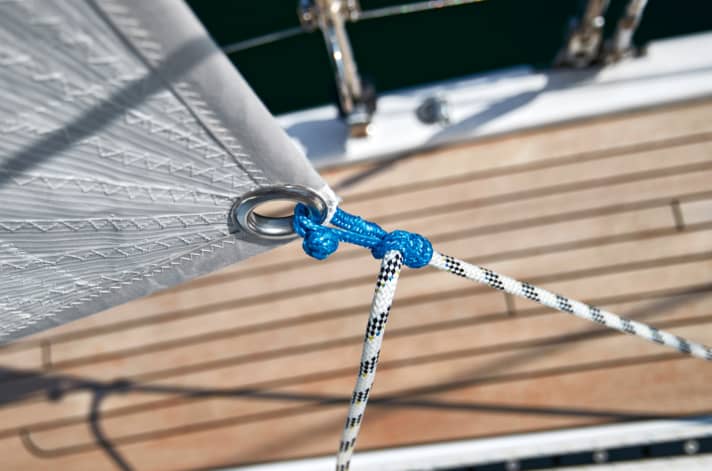
Advantages
- Knot builds up little
- Connection relatively easy to release
- Elegant contemporary method
- Variable length depending on rope shackle
- No pubic filing
Disadvantage
- Inflexible due to only one sheet
Connection 12: Prusik loop with rope shackle
This method combines a closed spliced loop with a soft shackle. These loops are also available ready spliced. The system is more complicated than a long rope shackle looped into a Prusik knot, but is even more variable in length. Prettier than a simple sling, but not functionally superior.

Advantages
- Knot builds up little
- Connection relatively easy to release
- Variable length depending on the loop
Disadvantages
- Unnecessary complication
- Rope shackle susceptible to shackles in the loop
- Inflexible due to only one sheet
Connection 13: Sheet with aluminium thimble
The thimble is placed in the core and rigged on both sides. This is only a solution for lighter loads and therefore smaller boats, as the thimble widens and raises the core. Alternatively, splice two sheets to a thimble. Push the cover back in front of it and then milk it over the splice. The sheet is attached to the sail with a rope shackle or a strop.
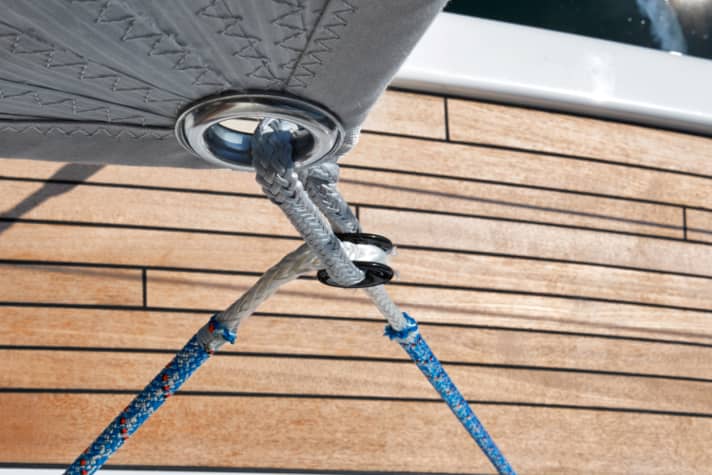
Advantages
- Knot builds up little
- Connection relatively easy to release
- No shaming due to aluminium thimbles
Disadvantages
- Inflexible due to only one sheet
- Even more metal that can hit the mast
- Higher costs due to thimbles
Connection 14: Sheets with splice and aluminium thimbles plus rope shackle
Combination of methods already shown. One less rope shackle, but you lose the possible flexibility of two sheets, as both are attached to a soft shackle. A diamond knot placed in the thimble reduces the risk of snagging.
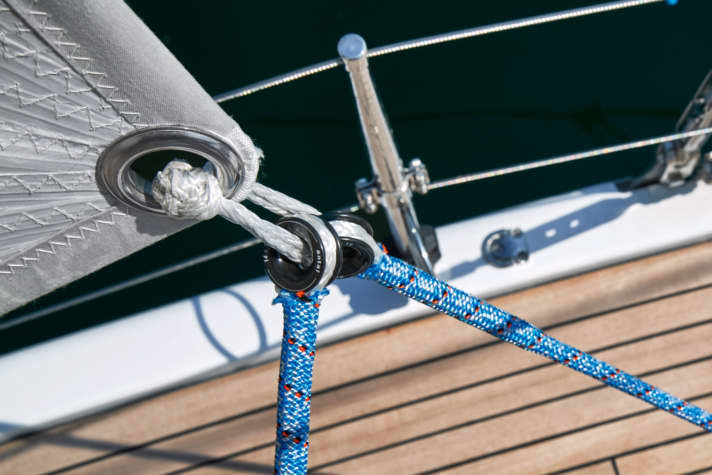
Advantages
- Knot builds up little
- Connection relatively easy to release
- Elegant contemporary method
- No shaming due to aluminium thimbles
Disadvantages
- Even more metal that can hit the mast
- Higher costs due to thimbles
- Two pods, but no flexibility
Connection 15: Professional splice with soft shackle
Eyes with cover are the highest quality splices for these applications. More difficult to make, but durable and protected from pubic filaments. Helpful rope shackles with short openers (red bands) that can get caught.
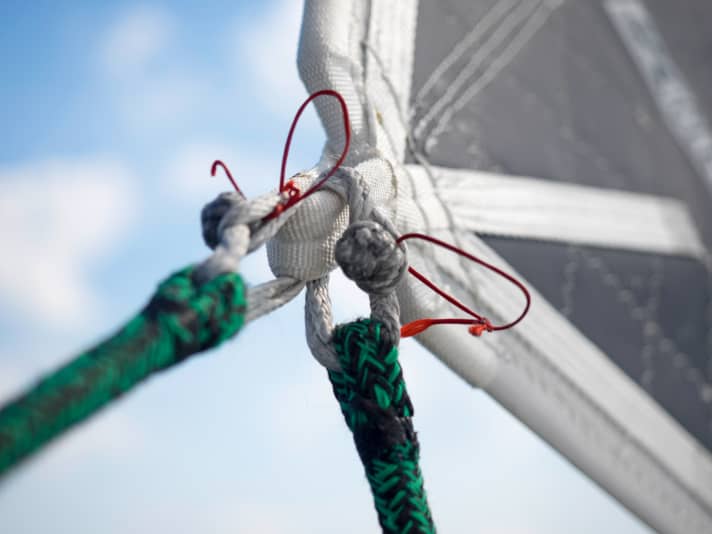
Advantages
- Connection easily detachable
- Elegant contemporary method
- High flexibility thanks to two pods
- Knots build up little/can be hidden in the clew
- Scuff protection due to jacket
Disadvantages
- More complex production
- Shackle openers can get stuck
Connection 16: Sheets with shackle
In times of high-performance fibres and easily spliceable braids, metal shackles are no longer a modern solution. The connection has major disadvantages, but is durable, tried and tested and long-lasting.
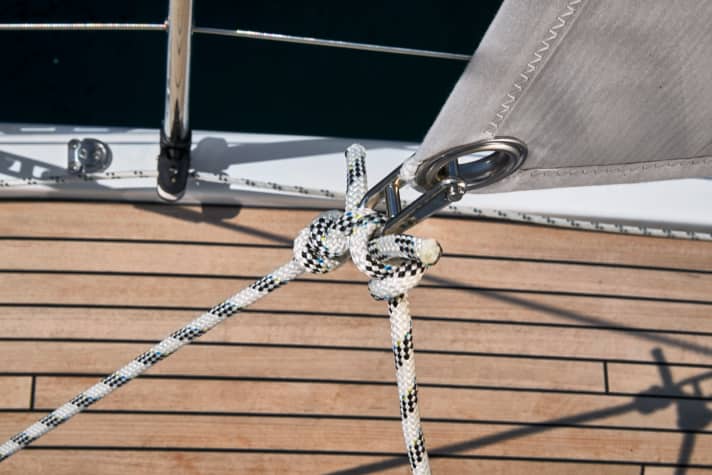
Advantages
- Connection easily detachable
- No pubic filing
- Various nodes possible
- Expandable with strop solutions
Disadvantages
- Shackle can hit the mast
- Higher risk of injury
- Higher costs due to shackles
- Low flexibility
Connection 17: With swivelling snap shackle
The two sheets are looped into the shackle ring with their eye splices. The snap shackle can also be released with clammy fingers using the strap. The swivelling eye has advantages if the sheets have not been laid out properly before setting or unfurling the sail.
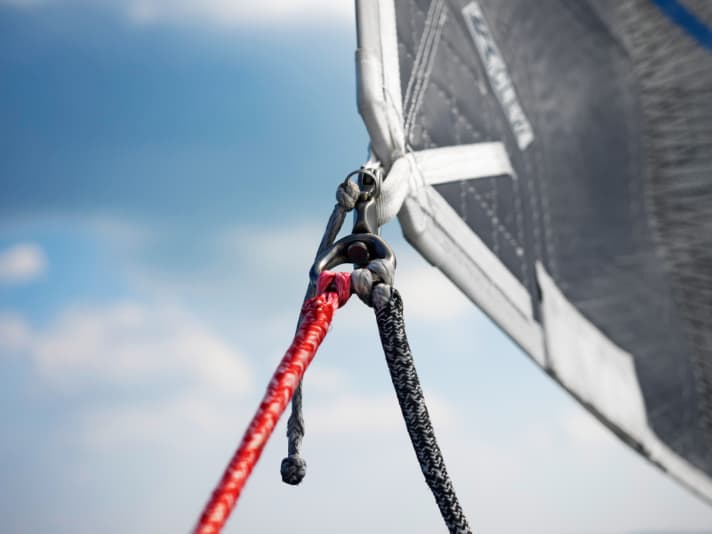
Advantages
- Connection easily detachable
- No pubic filing
- Expandable with strop solutions
Disadvantages
- Shackle can hit the mast
- Higher risk of injury
- Higher costs due to shackles
- Sheets cannot be detached during operation

